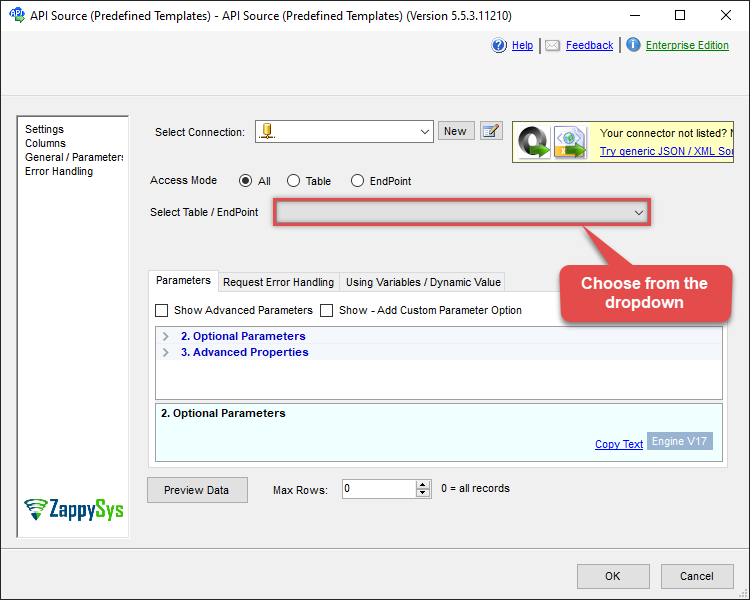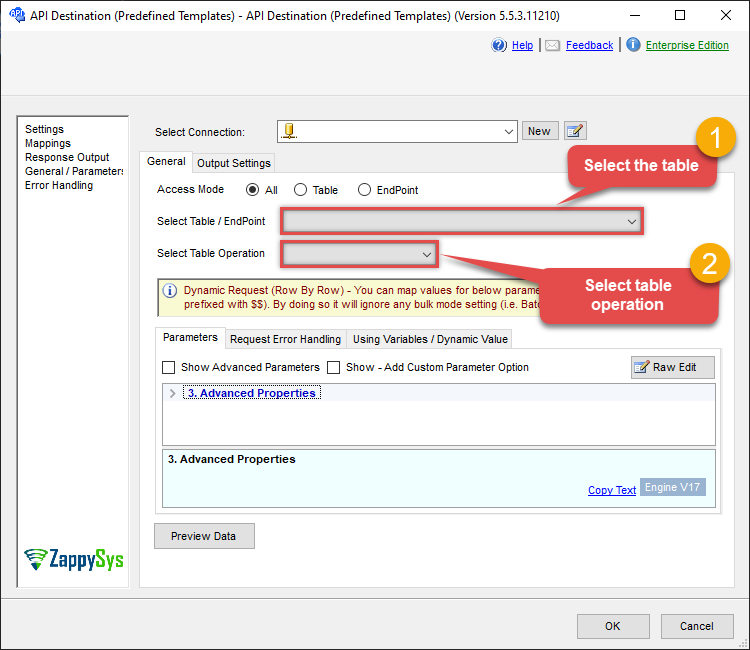Endpoint Make Generic API Request (Bulk Write)
Name
generic_request_bulk_write
Description
This is a generic endpoint for bulk write purpose. Use this endpoint when some actions are not implemented by connector. Just enter partial URL (Required), Body, Method, Header etc. Most parameters are optional except URL.
Related Tables
Generic Table (Bulk Read / Write)
Parameters
| Parameter | Required | Options |
|---|---|---|
|
Name:
Label: Url API URL goes here. You can enter full URL or Partial URL relative to Base URL. If it is full URL then domain name must be part of ServiceURL or part of TrustedDomains |
YES | |
|
Name:
Label: IsMultiPart Set this option if you want to upload file(s) using either raw file data (i.e., POST raw file data) or send data using the multi-part encoding method (i.e. Content-Type: multipart/form-data). A multi-part request allows you to mix key/value pairs and upload files in the same request. On the other hand, raw upload allows only a single file to be uploaded (without any key/value data). ==== Raw Upload (Content-Type: application/octet-stream) ===== To upload a single file in raw mode, check this option and specify the full file path starting with the @ sign in the Body (e.g. @c:\data\myfile.zip) ==== Form-Data / Multipart Upload (Content-Type: multipart/form-data) ===== To treat your request data as multi-part fields, you must specify key/value pairs separated by new lines in the RequestData field (i.e., Body). Each key/value pair should be entered on a new line, and key/value are separated using an equal sign (=). Leading and trailing spaces are ignored, and blank lines are also ignored. If a field value contains any special character(s), use escape sequences (e.g., for NewLine: \r\n, for Tab: \t, for at (@): @). When the value of any field starts with the at sign (@), it is automatically treated as a file you want to upload. By default, the file content type is determined based on the file extension; however, you can supply a content type manually for any field using this format: [YourFileFieldName.Content-Type=some-content-type]. By default, file upload fields always include Content-Type in the request (non-file fields do not have Content-Type by default unless you supply it manually). If, for some reason, you don't want to use the Content-Type header in your request, then supply a blank Content-Type to exclude this header altogether (e.g., SomeFieldName.Content-Type=). In the example below, we have supplied Content-Type for file2 and SomeField1. All other fields are using the default content type. See the example below of uploading multiple files along with additional fields. If some API requires you to pass Content-Type: multipart/form-data rather than multipart/form-data, then manually set Request Header => Content-Type: multipart/mixed (it must start with multipart/ or it will be ignored). file1=@c:\data\Myfile1.txt file2=@c:\data\Myfile2.json file2.Content-Type=application/json SomeField1=aaaaaaa SomeField1.Content-Type=text/plain SomeField2=12345 SomeFieldWithNewLineAndTab=This is line1\r\nThis is line2\r\nThis is \ttab \ttab \ttab SomeFieldStartingWithAtSign=\@MyTwitterHandle |
||
|
Name:
Label: Filter Enter filter to extract array from response. Example: $.rows[*] --OR-- $.customers[*].orders[*]. Check your response document and find out hierarchy you like to extract |
||
|
Name:
Label: Headers Headers for Request. To enter multiple headers use double pipe (||) or new line after each {header-name}:{value} pair |
Output Columns
| Label | Data Type (SSIS) | Data Type (SQL) | Length | Description | |||||||||||||||||||||||||||||||||||||||||||||||||||||||||||||||||||||||||||||||||||||||||||||||
|---|---|---|---|---|---|---|---|---|---|---|---|---|---|---|---|---|---|---|---|---|---|---|---|---|---|---|---|---|---|---|---|---|---|---|---|---|---|---|---|---|---|---|---|---|---|---|---|---|---|---|---|---|---|---|---|---|---|---|---|---|---|---|---|---|---|---|---|---|---|---|---|---|---|---|---|---|---|---|---|---|---|---|---|---|---|---|---|---|---|---|---|---|---|---|---|---|---|---|---|
| There are no Static columns defined for this endpoint. This endpoint detects columns dynamically at runtime. | |||||||||||||||||||||||||||||||||||||||||||||||||||||||||||||||||||||||||||||||||||||||||||||||||||
Input Columns
| Label | Data Type (SSIS) | Data Type (SQL) | Length | Description | |||||||||||||||||||||||||||||||||||||||||||||||||||||||||||||||||||||||||||||||||||||||||||||||
|---|---|---|---|---|---|---|---|---|---|---|---|---|---|---|---|---|---|---|---|---|---|---|---|---|---|---|---|---|---|---|---|---|---|---|---|---|---|---|---|---|---|---|---|---|---|---|---|---|---|---|---|---|---|---|---|---|---|---|---|---|---|---|---|---|---|---|---|---|---|---|---|---|---|---|---|---|---|---|---|---|---|---|---|---|---|---|---|---|---|---|---|---|---|---|---|---|---|---|---|
| There are no Static columns defined for this endpoint. This endpoint detects columns dynamically at runtime. | |||||||||||||||||||||||||||||||||||||||||||||||||||||||||||||||||||||||||||||||||||||||||||||||||||
Examples
SSIS
Use Zoho CRM Connector in API Source or in API Destination SSIS Data Flow components to read or write data.
API Source
| Required Parameters | |
|---|---|
| Url | Fill-in the parameter... |
| Request Method | Fill-in the parameter... |
| Optional Parameters | |
| IsMultiPart | |
| Filter | |
| Request Format (Content-Type) | Default |
| Body | {$rows$} |
| JsonOutputFormat | Multicontent |
| DoNotOutputNullProperty | |
| Batch Size (Default=1) | 1 |
| Meta Detection Order | StaticDynamicVirtual |
| Input Columns - For Mapping (e.g. MyCol1:string(10); MyCol2:int32 ...) - Use bool, int32, int64, datetime, decimal, double | |
| Output Columns (e.g. MyCol1:string(10); MyCol2:int32 ...) - Use bool, int32, int64, datetime, decimal, double | |
| Request Format | |
| Response Format | Default |
| Headers | Accept: */* || Cache-Control: no-cache |
| Csv - Column Delimiter | , |
| Csv - Row Delimiter | {NEWLINE} |
| Csv - Quote Around Value | True |
| Csv - Always Quote regardless type | |
| Encoding | |
| CharacterSet | |
| Writer DateTime Format | |
| Csv - Has Header Row | True |
| Xml - ElementsToTreatAsArray | |
| Layout Map | <?xml version="1.0" encoding="utf-8"?> <!-- Example#1: Output all columns --> <settings> <dataset id="root" main="True" readfrominput="True" /> <map src="*" /> </settings> <!-- Example#2: Records under array <?xml version="1.0" encoding="utf-8"?> <settings singledataset="True"> <dataset id="root" main="True" readfrominput="True" /> <map name="MyArray" dataset="root" maptype="DocArray"> <map src="OrderID" name="OrderID" /> <map src="OrderDate" name="OrderDate" /> </map> </settings> --> <!-- Example#3: Records under nested section <?xml version="1.0" encoding="utf-8"?> <settings> <dataset id="dsRoot" main="True" readfrominput="True" /> <map name="NestedSection"> <map src="OrderID" name="OrderID_MyLabel" /> <map src="OrderDate" name="OrderDate_MyLabel" /> </map> </settings> --> |

API Destination
This Endpoint belongs to the Generic Table (Bulk Read / Write) table, therefore it is better to use it, instead of accessing the endpoint directly. Use this table and table-operation pair to make generic api request:
| Required Parameters | |
|---|---|
| Url | Fill-in the parameter... |
| Request Method | Fill-in the parameter... |
| Optional Parameters | |
| IsMultiPart | |
| Filter | |
| Request Format (Content-Type) | Default |
| Body | {$rows$} |
| JsonOutputFormat | Multicontent |
| DoNotOutputNullProperty | |
| Batch Size (Default=1) | 1 |
| Meta Detection Order | StaticDynamicVirtual |
| Input Columns - For Mapping (e.g. MyCol1:string(10); MyCol2:int32 ...) - Use bool, int32, int64, datetime, decimal, double | |
| Output Columns (e.g. MyCol1:string(10); MyCol2:int32 ...) - Use bool, int32, int64, datetime, decimal, double | |
| Request Format | |
| Response Format | Default |
| Headers | Accept: */* || Cache-Control: no-cache |
| Csv - Column Delimiter | , |
| Csv - Row Delimiter | {NEWLINE} |
| Csv - Quote Around Value | True |
| Csv - Always Quote regardless type | |
| Encoding | |
| CharacterSet | |
| Writer DateTime Format | |
| Csv - Has Header Row | True |
| Xml - ElementsToTreatAsArray | |
| Layout Map | <?xml version="1.0" encoding="utf-8"?> <!-- Example#1: Output all columns --> <settings> <dataset id="root" main="True" readfrominput="True" /> <map src="*" /> </settings> <!-- Example#2: Records under array <?xml version="1.0" encoding="utf-8"?> <settings singledataset="True"> <dataset id="root" main="True" readfrominput="True" /> <map name="MyArray" dataset="root" maptype="DocArray"> <map src="OrderID" name="OrderID" /> <map src="OrderDate" name="OrderDate" /> </map> </settings> --> <!-- Example#3: Records under nested section <?xml version="1.0" encoding="utf-8"?> <settings> <dataset id="dsRoot" main="True" readfrominput="True" /> <map name="NestedSection"> <map src="OrderID" name="OrderID_MyLabel" /> <map src="OrderDate" name="OrderDate_MyLabel" /> </map> </settings> --> |

ODBC application
Use these SQL queries in your ODBC application data source:
Make generic api request
SELECT * FROM __DynamicRequest__
WITH
(
"Url" = '/something/123',
"RequestMethod" = 'POST'
)
generic_request_bulk_write endpoint belongs to
__DynamicRequest__
table(s), and can therefore be used via those table(s).
SQL Server
Use these SQL queries in SQL Server after you create a data source in Data Gateway:
Make generic api request
DECLARE @MyQuery NVARCHAR(MAX) = 'SELECT * FROM __DynamicRequest__
WITH
(
"Url" = ''/something/123'',
"RequestMethod" = ''POST''
)';
EXEC (@MyQuery) AT [LS_TO_ZOHO_CRM_IN_GATEWAY];
generic_request_bulk_write endpoint belongs to
__DynamicRequest__
table(s), and can therefore be used via those table(s).
